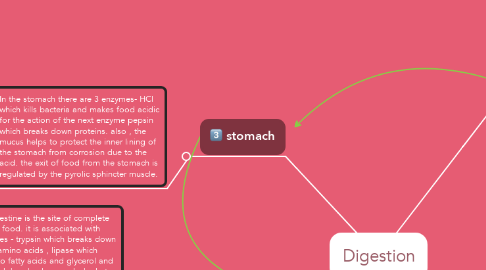Digestion
by Ananya M Jose

1. stomach
1.1. In the stomach there are 3 enzymes- HCl which kills bacteria and makes food acidic for the action of the next enzyme pepsin which breaks down proteins. also , the mucus helps to protect the inner lining of the stomach from corrosion due to the acid. the exit of food from the stomach is regulated by the pyrolic sphincter muscle.
2. small intestine
2.1. the small intestine is the site of complete digestion of food. it is associated with three enzymes - trypsin which breaks down proteins to amino acids , lipase which breaks fats to fatty acids and glycerol and amylase which breaks down carbohydrates to glucose.
2.2. The small intestine has a number of finger like projections called villi which increase the surface area for absorption of the digested food. They are richly supplied with blood vessels which take the absorbed food into the blood stream.
3. large intestine
3.1. All the unabsorbed food is sent to the large intestine. its wall absorbs water from this material. the rest of the material is moved to the anus for excretion.
4. some associated glands
4.1. salivary glands in the mouth help in moistening the food.
4.2. the largest gland in our body, the liver secrets bile which helps in emulsification of fats and in making the food alkaline for the action of pancreatic enzymes.
4.3. pancreas secretes three main enzymes - amylase, trypsin and lipase.
5. oesophagus
5.1. The food from the mouth passes through the pharynx. It then moves into the oesophagus and then the stomach. It is pushed forward in the oesophagus by peristaltic movements.
6. mouth (buccal cavity)
6.1. The mouth is also called the buccal cavity. Here the teeth help in mechanical digestion. The salivary amylase converts the starch into simple sugar.
7. anus
7.1. All the undigested food is excreted out from the anus.


